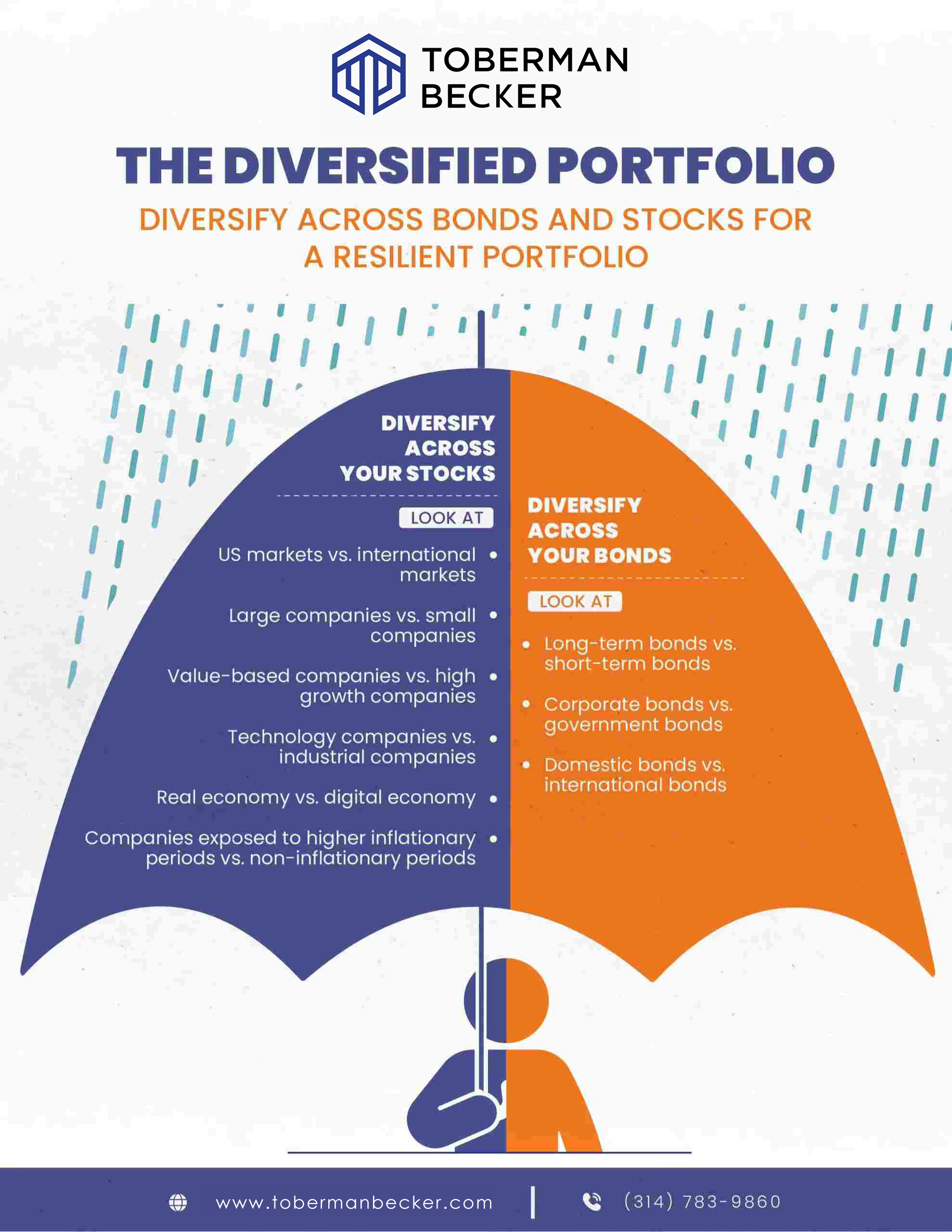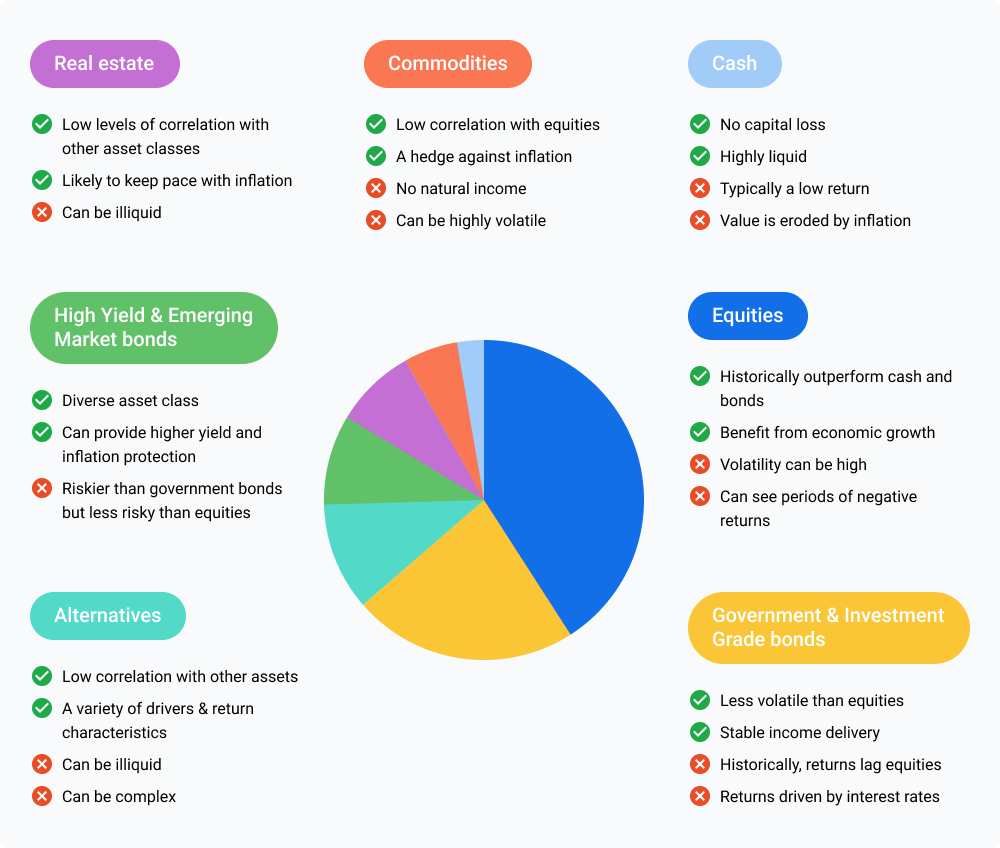What’s the Best Way to Diversify My Investment Portfolio for Retirement?

When you invest, you take on risk. If you want to maximize your chances of keeping up with long-term inflation, there’s no way around it. Though it’s impossible to avoid all risk in your stock portfolio, it can be reduced. It’s unrealistic to expect your retirement portfolio to consistently do well and never go through periods of volatility, but hedging against risk is the best way to avoid those extreme high and low fluctuations that can throw a curveball into your long term financial goals. A diversified portfolio is one of the best ways to hedge against risk.
As a financial advisor, my number one priority is to ensure that my clients achieve as much return as possible on their retirement savings per unit of investment risk assumed. Said another way, we aim to achieve the investment rate of return needed in the long-term to secure a successful retirement, while taking as little risk as absolutely necessary to maximize the chances of this desired outcome. In this article, I’ll discuss why it’s important and necessary to create a diversified investment portfolio to add protection against recession, inflation, and volatility.
1. Why is it important to diversify your portfolio?
When it comes to the ever-changing world of investing, the most absolute, constant, and universal recommendation I can make is this: diversify your portfolio.
Diversification is not a new concept in the world of finance and it is single-handedly the most important step you can take in ensuring your portfolio enjoys the smoothest ride possible throughout retirement.
We’ve all heard the phrase “Don’t put all your eggs in one basket”. Well, the same goes for investing. When you diversify, you spread out your investments and strategically balance them. By doing this, your portfolio can work toward consistent success in different markets and at different times. This makes the highs and lows more gradual, portfolio planning more predictable, and forecasting your future retirement more accurate.
By diversifying your portfolio you can:
- Achieve long-term financial goals with the least amount of volatility.
- Reduce the amount of extreme fluctuations.
- Gain similar investment returns per unit of investment risk assumed.
- Prevent your investment assets from being too heavily weighted toward one company or sector.
- Minimize the risk of one bad event taking out your entire portfolio.
Our world is complex and unpredictable. No one can forecast where the global economy, macro environment, and interest rates are heading, but we can weather the storm by always bringing along our “umbrella” for when the market gets volatile.
“The first rule of an investment is don’t lose [money]. And the second rule of an investment is don’t forget the first rule.
-Warren Buffet
2. Using Modern Portfolio Theory to implement a diversified strategy
A chart demonstrating Modern Portfolio Theory.
Source: Forbes Advisor
First introduced by American economist Harry Markowitz, the Modern Portfolio Theory (MPT) is an empirical and popular framework to follow when building your diversified portfolio.
According to the theory, one must select their investments in order to maximize their overall returns within an acceptable level of risk. For example, the more return you seek, the higher the level of risk you must be willing to bear. And since it’s never a good idea to zig zag the market, the risk you choose must be the risk you’re willing to stand by throughout the highs and lows of the market.
This is why I tell my clients to seek some degree of noncorrelation in their holdings when selecting their investments. Then, plan on holding a disciplined portfolio for the long-term, monitoring and adjusting when needed, and staying the course to let storms pass as they come.
By considering a multitude of investments that are not highly correlated with each other, you’re creating a portfolio that does well in different market environments. For example, Microsoft and Apple correlate with each other. They’re both two of the biggest tech companies in the world, they’re both US companies, and they’re both fighting for that number one spot. If you want one that’s less correlated, choose a company in Europe that does manufacturing. Then, during times of market volatility, the likelihood of both companies performing poorly to the same extent at the same time is comparably minimized.
Here are a few examples of ways to bring along that “umbrella” we talked about above:
Diversify across your stocks:
- U.S. markets vs. international markets
- Large companies vs. small companies
- Value-based companies vs. high growth companies
- Technology companies vs. industrial companies
- Real assets vs. digital assets (i.e., atoms vs. bits)
- Companies exposed to higher inflationary periods vs. dis-inflationary periods
Diversify across your bonds:
- Long-term bonds vs. short-term bonds
- Corporate bonds vs. government bonds
3. Steps to creating a diversified portfolio
A chart demonstrating Portfolio Diversification.
Source: Fidelity
1. Introductory meeting
This first step, and most important step, is getting to know our clients, their specific circumstances, and their future plans in conjunction with their retirement. We ask a lot of questions, make a lot of projections, and hit on key topics relevant to their unique circumstances.
Based on our discussion and the client’s psychological cues from topics addressed, we start to define their financial goals, and make recommendations based on our experience. We create a long-term financial plan, taking into account a high level diversification that best fits the client’s objectives for the next 30 years.
This is the first and most important step you can take towards determining how to diversify your stocks and bonds.
2. Establish risk tolerance
Next, we take the portfolio we created together and stress test our client’s goals. Our objective is to assess the amount of risk they are willing and able to bear. This allows us to see the rate of investment return required to pursue without taking on unnecessary risk.
We base this phase off of two factors:
- Your ability to take on and bear risk:
This is based on your age and time horizon on which you need to spend your funds. - Your willingness to take on and bear risk:
This is based on your psychological factors like how emotionally tolerant you are of volatility in financial markets and how they might impact your life savings.
Using the Monte Carlo Simulation Method and applying it to your future retirement cash flows, we consider the “what-if scenarios”. We take the data and visualize various scenarios that could take place in your financial future. By taking a comprehensive and thorough look, we’re able to design a diversified portfolio that works efficiently for you while also decreasing the likelihood of an outsized negative outcome. By being aware of these different scenarios and making sure these bases are covered, the stress, worry, and fear about the resiliency of your retirement nest egg will be relieved, creating a smoother ride for yourself.
After establishing your risk tolerance, we then can return back to step one (as many times as needed) and adjust the portfolio so it functions within your risk tolerance and retirement objectives.
3. Create a plan and build the portfolio
Based on step one and step two, we start to construct a portfolio that represents you, your goals, your risk tolerance, and hedges against risk to the extent practicable. We make decisions based on our financial modeling and retirement projection process, thinking about what needs must be met to meet your goals, all the while considering how to best diversify your investments though stocks and bonds.
Once you figure out how much investment return is necessary to support your lifestyle and goals for the rest of your life, then there’s no sense in taking any added risk to achieve that desired result. Our objective is to create a steady rate of returns while experiencing as little volatility within your portfolio as possible.
4. Monitor and adjust as necessary
As a financial advisor, it is our responsibility to construct, implement, monitor, and review your retirement portfolio on a regular basis to ensure your investments are aligned with your financial goals. We monitor the macro environment, observe how the portfolio is responding, and adjust to ensure the portfolio adapts to new goals you may have. If the portfolio needs to be rebalanced to realign with the original prescription or a life change, we use our experience to do so without causing unnecessary disruption.
How does a financial advisor help long term?
As a financial advisor, I’m constantly asked by my clients what my opinion of a 60/40 portfolio is (that is, 60% stocks / 40% fixed income). Though considering a 60/40 portfolio is a good starting point, it’s a more complex process. Despite what you may hear, there’s no secret potion that guarantees a successful portfolio. It’s an individualized work in progress and benefits from an experienced financial advisor. We don’t set it and forget it or use a robotic algorithm to predict the future (like predicting the weather, that’s impossible in the present day). Rather, we use our experience to weigh many data points, synergize them, and produce an output designed to benefit you.
In Conclusion
Everyday I work with real human beings. They’re on a financial journey with a future that needs to be protected and I am a 30 year partner in that endeavor.
Toberman Becker Wealth is a fee-only, independent fiduciary firm based out of St. Louis. Our priority is to help you live comfortably now, without sacrificing your financial future later. Whether starting to invest for retirement in your 50s or actively planning for retirement in your 60s, I help people nearing a transition build a resilient retirement plan. I operate in the best interests of our clients, always, and my top priority is to help you live comfortably now, without sacrificing your financial future later.
If you’re looking for an investment advisor to help you build a diversified strategy that hedges against risk, feel free to book a meeting or give us a call.
Disclosure: Any mention of a particular security and related performance data is not a recommendation to buy or sell. The information provided on this website (including any information that may be accessed through this website) is not directed at any investor or category of investors and is provided solely as general information. Nothing on this website should be considered as personalized financial advice or a solicitation to buy or sell any securities.
Craig Toberman is a Partner at Toberman Becker Wealth – a fee-only, fiduciary financial advisor based in St. Louis. He assists families and businesses with strategic financial planning and long-term wealth management. He has over a decade of experience in financial services and has crafted custom financial plans for hundreds of families and businesses.



